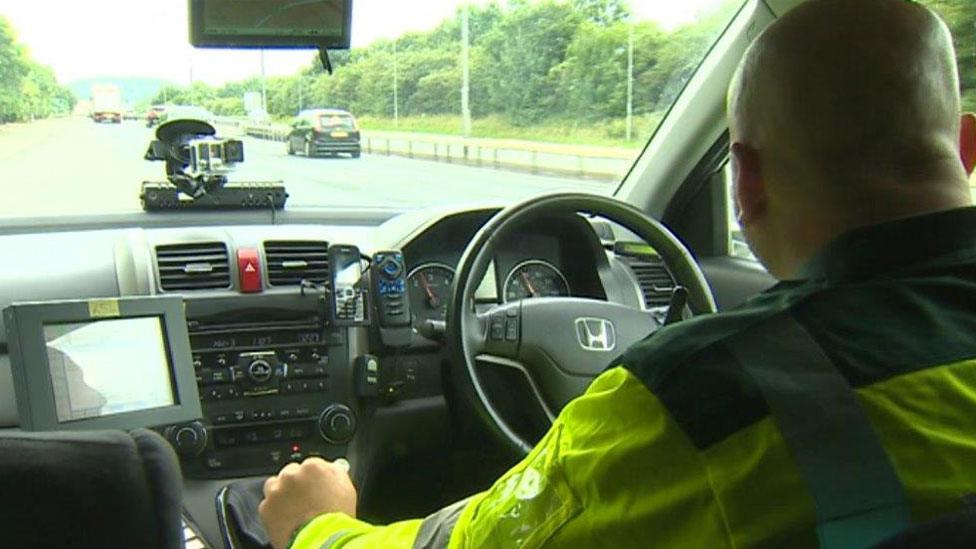Analysis: Welsh Ambulance Service performance in detail
- Published

We now have a far more detailed picture of how the Welsh Ambulance Service is performing, thanks to a new set of figures.
As well as how quickly ambulances arrive, the statistics which come out every three months, external also tell us how patients were treated, how long it takes for ambulances to be able to hand over patients once they arrive at hospital.
They also tell us how many hours are wasted by ambulances having to stand around waiting to transfer over patients at hospitals.
The latest figures come nine months into a trial of a new system for handling 999 calls.

'Red' category emergency calls
For the last nine months, calls have been split into red, amber and green.
The red calls are assessed as those with an immediate threat to life: it could be someone having a heart attack, unconscious or bleeding.
The idea is by prioritising these calls, more lives will be saved. The old 65% target for arriving within eight minutes still stands for these.
Under the new system, far fewer calls are designated as red.
Whereas before around 40% of 999 calls were subject to a eight minute time target - now it is just the most critical 10% or so.
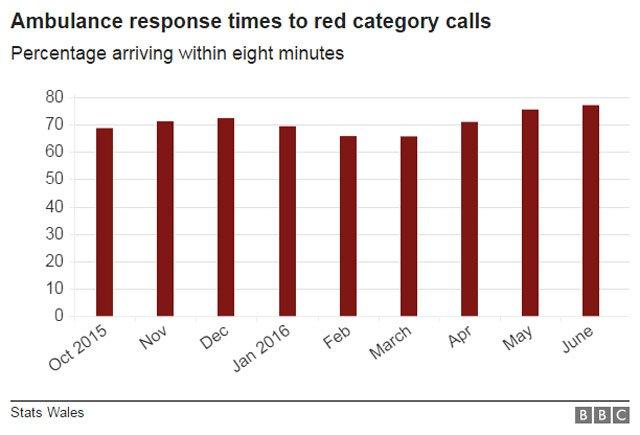
When we look at the number and percentage of red category calls arriving within eight minutes we see more than 10,000 in the nine months until the end of June.
In February and March, the ambulance service barely made the 65% target - 65.8% and 65.7% - suggesting the pressures the NHS is under over the traditional winter months although the number of "red" calls was higher in three other months.

Median response times
Another statistic is to look at the average waiting time for patients after 999 has been dialled.
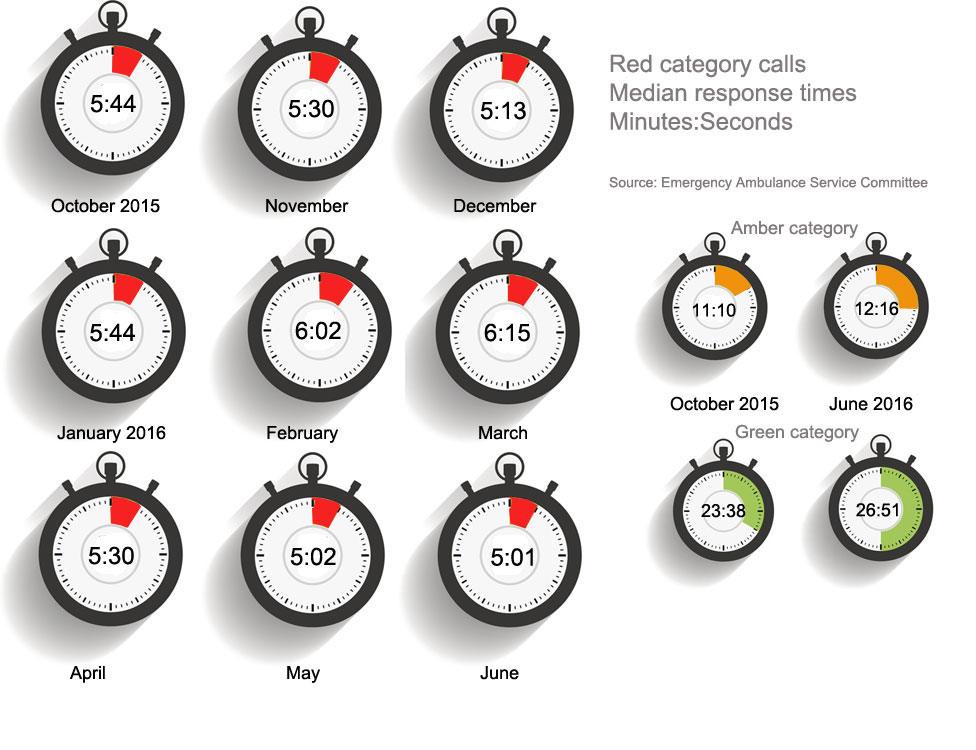
This shows the median response times for each month since October
The median response times show how quickly ambulances on average take to arrive.
You can see from the graphic above that last October, the median response time for red calls was five minutes 44 seconds. In the last two months, it has come down to just over five minutes.
"Amber" calls include patients who may need taking quickly to hospital or could be treated at the scene. But there is no immediate danger. So, these type of calls are taking longer. From 11 minutes 10 seconds last October, to an average 12 minutes 16 seconds in June.
But ambulance management say rather than crude time measurements they are looking carefully at the type of treatment patients are getting - and these quality indicators are harder to achieve.
The thinking is, that as long as the patient gets the treatment they need, waiting a little longer for an ambulance will not affect their overall health in the end.
The "green" calls are far less urgent and can often end up with local treatment at a GP surgery. If an ambulance is dispatched for this type of call it used to take a median 23 minutes 38 seconds but in June it was 26 minutes 51 seconds.
"The more people we can manage over the telephone and provide care by signposting them to the right part of the NHS, means we have more ambulances available to go to those life-threatening calls," said Richard Lee, director of operations for the Welsh Ambulance Service.

Routes other than hospitals
There is also a measure about how many 999 calls result in a patient not being taken to hospital.
Nearly 8% of callers are transferred to NHS Direct for further advice.
Around 30% of 999 patients do not end up being taken to hospital. In the last three months, 14,262 patients were either treated at the scene or transferred to another care provider.
"Not everybody who goes into an emergency department needs to go into an emergency department and in some cases it was the wrong place for them to go," Stephen Harrhy, chief ambulance service commissioner for Wales, said.
He said the number of patients not going to emergency departments was increasing and he fully expected that to rise.

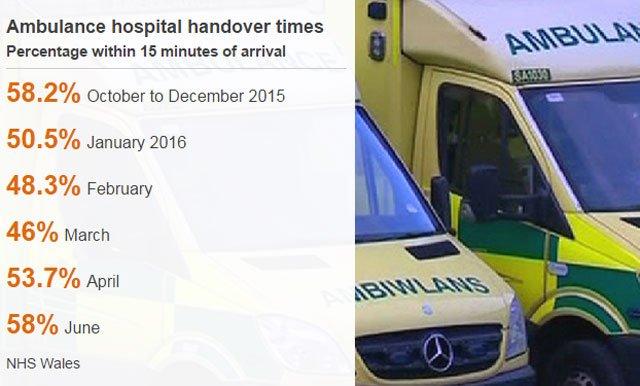
Number and percentage of notification to handover within 15 minutes of arrival at hospital
These figures look at the time ambulances have to wait outside hospitals before they can hand over the patient.
This is not so much a measure of the performance of the ambulance service as to how the whole hospital system is working.
You can also see how the winter pressure problems have their effect here - with the percentage of patients being handed over within 15 minutes dropping.
At major A&E units, the percentage drops from nearly 61% in December to less than 46% in March.
In terms of numbers, 35,000 patients were handed over within 15 minutes in the three months to the end of December, while it dropped to nearly 29,000 in January to March.

Number of lost hours following notification to handover over 15 minutes
The ambulance service has previously calculated it costs £76 for each "lost" hour an ambulance spends outside hospital.
The figures show how in the nine months since October this could be more than £3.5m, with more than 46,671 lost hours.
This is the equivalent of nearly five and a quarter years.
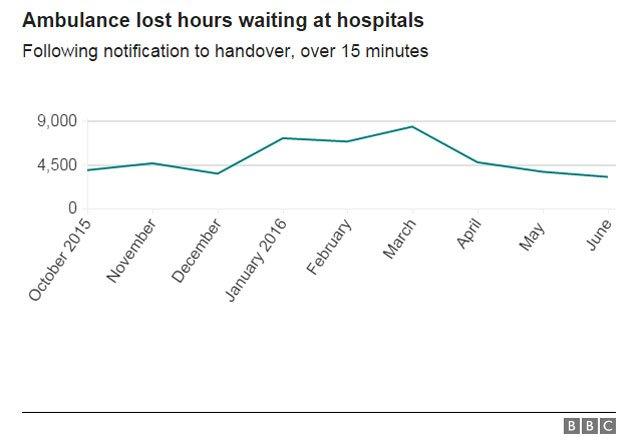
Richard Lee said the ambulance conveyance rate was a priority to end queues outside emergency units - and it was ultimately about only taking patients to hospital when they really needed to be there.
"When we send an ambulance to assess and treat the patient, the more often we can refer them to a community service means we don't take that patients to hospital," he said.
"We only get queues of ambulances outside hospital when we take patients to hospital so the system has to be re-set to keep more patients into the community."

Number of frequent callers
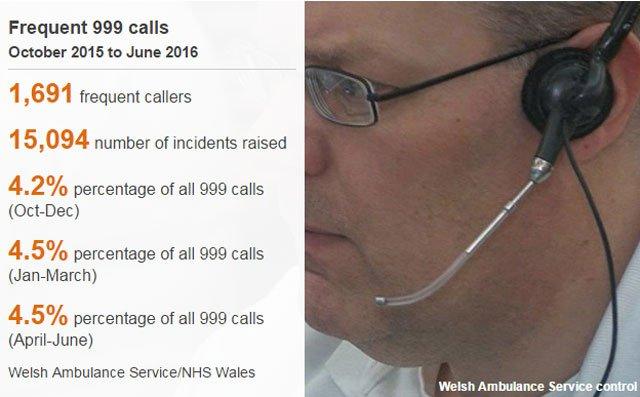
There are concerns that ambulance "frequent callers" who make several or multiple 999 calls a year are tying up ambulance vehicles and paramedics and could be costing the service thousands of pounds.
More than 15,000 have been made since last October.
Measuring the number of calls made by these individuals allows the service to judge the scale of the problem.
Frequent callers may or may not have an urgent medical need - but often those who regularly call the service may have developed an unhealthy pattern of dependent behaviour - and could be offered support or care in a different way.
The new model means the ambulance service can for example work with social services to identify and support those who frequently dial 999.
Some callers were found to be calling 100 times a year. In one example, a Cardiff patient had an alcohol dependency problem which led to them making 36 999 calls, taking up nearly 32 hours of ambulance time.
It was arranged for meetings with the patient's GP and an admission for treatment and the number of calls was drastically reduced.
A woman from Barry was jailed on Tuesday after making more than 400 times in two years. The ambulance service said court action was taken "as a final deterrent" after an escalation in her behaviour.

Quality over time
While the time targets have been scrapped for all but the most urgent of calls, all of them are being measured against a new set of criteria which aims to assess the quality of the care given to the patient.
For example there are indicators which look at whether or not patients who have had a stroke, heart attack or have fallen and broken their hips get the right type of care when it is needed
And there will be more of these "clinical measures" introduced as the model evolves.
The argument is that the previous system was too blunt focused entirely on speed.
The new model is a more refined taking into account the effect on patients.
- Published27 July 2016
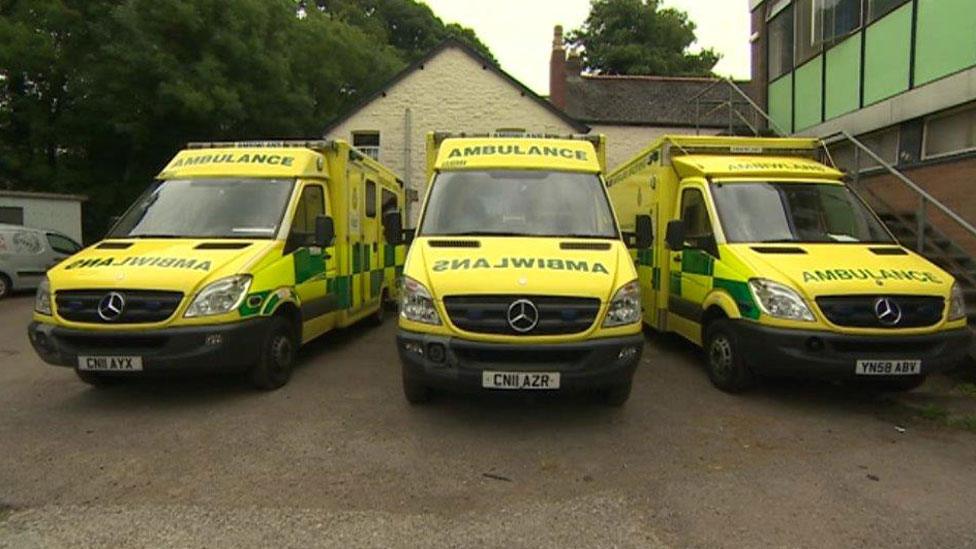
- Published27 July 2016
